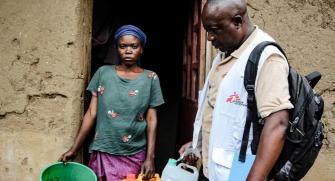Case-Area Targeted Intervention to contain or shorten the duration of cholera outbreaks (CATI)
Context
The risk of small-scale cholera outbreaks propagating rapidly and enlarging extensively remains substantial. As opposed to relying on mass, community-wide approaches, cholera control strategies could focus on proactively containing the first clusters. Case-area targeted interventions (CATI) are based on the premise that early detection can trigger a rapid, localised response in the high-risk radius around one or several case-households to reduce transmission sufficiently to extinguish the outbreak or reduce its spread. Current evidence supports a highrisk spatiotemporal zone of 100 to 250 meters around case-households for 7 days.
We hypothesize that the prompt application of CATI will reduce household transmission and transmission in the wider ring. This will result in reduced incidence in the ring and reduced clustering of cases. The local focus of CATI will enable active case-finding and sustained uptake of interventions. This will result in prompt access to care for detected cases, and reduced mortality and community transmission.
Objective
We propose to evaluate the effectiveness of a CATI strategy using an observational study design during an acute cholera epidemic, with clearly-defined measures of the effectiveness of the CATI package. In addition, we intend to evaluate the feasibility, costs, and process of implementing this approach.
Methods
The CATI package delivered by Médecins Sans Frontières (MSF) incorporates key transmission-reducing interventions (including household-level water, sanitation, and hygiene measures, health promotion, active case-finding, antibiotic chemoprophylaxis, and, single-dose oral cholera vaccination (OCV)).
The study design is based on comparing the effects of CATIs that rapidly provide protection in averting later generations of cases when compared with CATIs delayed by operational constraints (delays will not be assigned nor randomized). A regression analysis will be used to model the observed incidence of enriched RDT-positive cholera as a function of the delay to intervention (in days). The delay will reflect the inverse strength of rapid response. Groups, as a function of their delays to intervention, will serve as internal controls.
Country
DRC
Status
Ongoing analysis
Our Role
Study design, Coordination, Implementation, Analysis
Who's Involved
OCG, OCB, OCP, OCBA, OCA
LSHTM
Preliminary results
During the study period, CATI has been implemented by 4 MSF operational sections in 118 rings in 5 different sites in the Democratic Republic of the Congo. The median number of households in each ring was 69. The median administrative vaccination coverage achieved was 89% across all sites. The median delay to CATI implementation was of 2 days from the onset of symptoms of the primary case, and the delay to vaccination was 3.5 days. The characteristics of the CATI rings varied widely across sites and between individual rings. The number of secondary cases observed in rings was generally low, no secondary case was observed in overs 75% of all rings.
Preliminary results show that rapidly implementing CATI with vaccination to contain cholera cases is feasible and that the coverage of the different interventions is satisfactory. A more detailed analysis of effectiveness, coverage and resource needs is underway.









